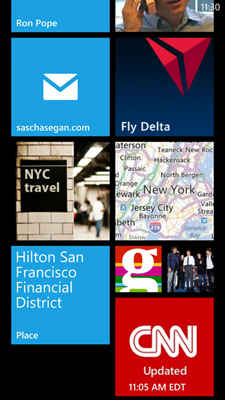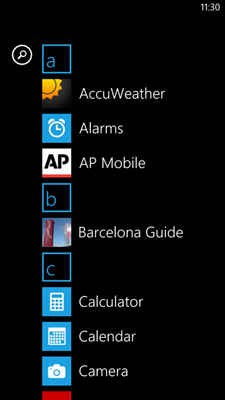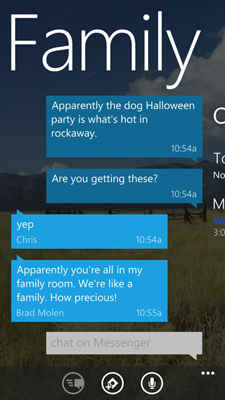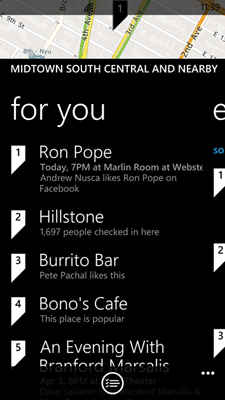Microsoft Windows Phone 8 Review
Windows Phone 8 is a good-looking, well-designed, easy-to-use mobile operating system, but with a very different set of apps compared with other platforms, it’s still for mavericks.
But pick up a Windows Phone 8, and you’ll be a maverick. There’s significantly less of a selection of apps here than for Android and iOS, and the apps are different. The odds are good that you’ll find what you need, but the goods are odd. That makes a Windows Phone less of an easy purchase than it could be.
Launched in 2010, Windows Phone 7 wasn’t much of a competitor to iOS and Android in large part because it ran on uninspiring hardware, but Windows Phone 8 will help fix that. While WP8 still only supports Qualcomm processors, at least it supports current Qualcomm processors, along with high-resolution screens and the latest wireless specs. So Windows Phone 8 devices like the HTC 8X and the Nokia Lumia 920 will do a better job facing off against the iPhone 5 and the Samsung Galaxy S III $179.99 at Amazon Wireless on power than, say, the HTC Trophy managed to pull off at the end of its long lifespan. (There’s one perplexing lack, though: No decent QWERTY handsets yet.)
I reviewed WP8 on an HTC Windows Phone 8X. We’ll have a full review of the phone when U.S. carrier models appear early next month, but for now see our hands-on story from when the device was announced.
If this is your first time even thinking about Windows Phone, take a look at our reviews of Windows Phone 7 and Windows Phone 7.5. While it’s built on completely different underpinnings, Windows Phone 8 works much like its predecessors.
The Underpinnings
The familiar interface of Windows Phone 7 hides a radical change under the hood. Windows Phone 8 now runs on the same kernel as Windows 8, including the NTFS file system and the ability for third-party developers to write native code rather than having to go through Silverlight or XNA. It’s still compatible with the 125,000 Windows Phone 7 apps, but it’s potentially much more powerful because there are more ways to develop for it.
That’s mostly potential, though, because Microsoft didn’t release the Windows Phone 8 SDK to most developers in advance. So far, it’s hard to find Windows Phone 8-only apps that use the new development strategies. Hopefully, they’ll start showing up soon.
I’m very excited by an invisible feature called Data Sense, which works like our Editors’ Choice Android and iPhone app Onavo Extend. It compresses your data using Microsoft servers, letting you get more out of limited data plans. It also keeps you updated on how much data you’ve used.
Unfortunately, until sometime next year it’s a Verizon exclusive. In the name of “carrier differentiation,” consumers won’t likely be able to get what they want. Want a Nokia Lumia 920? It’s AT&T only. Want a phone with data compression and monitoring? Verizon only. Want a Lumia 920 with Data Sense? Nope.
Windows Phone 8 also backs up your settings, data and apps into the cloud, just like Android and iOS do. You can find, lock, or erase a phone remotely, too. That makes it easy to move between Windows Phone devices or to restore a lost or stolen phone.
The Lock Screen, Tiles, and Hubs
To understand why you would want to use Windows Phone 8, you have to understand tiles. Like icons, but not quite, tiles are squares you plonk on the home screen representing the items you want to access easily. Apps, sure, but also contacts, places, collections of apps called “hubs,” media items, or Web pages, among other things. Right now I have a map to my hotel and a FlightStats page about my flight pinned to my home screen, for instance. You can do that on Android, but it’s not nearly as simple.
Tiles can be “live,” which means they flip around automatically to show new information. Your Me tile is constantly pinging you with new social-networking updates. A FlightAware tile would flip around if your flight were, say, cancelled; a Photos tile usually shows the latest pictures you’ve taken. (None of this seems to affect battery life much.) You can make tiles in three different sizes, 20 different colors, and snap them together in various ways, so what you end up with is a visually coherent but constantly shifting landscape of relevant data.
The Lock screen is “live,” too. Apps can feed data to the Lock screen, ghosting the latest news, weather, or your travel information behind the standard date and time. You can also set which apps send alerts to the lock screen.
The result is just as configurable as Android, but much more visually striking. Live tiles display information the same way widgets do, but the enforced visual uniformity makes a Windows Phone 8 home screen look smartly configured, rather than like a yard-sale jumble.
Along with tiles, Microsoft’s second central concept is Hubs. The People hub, Games hub, Photos hub, and Music & Video hub are places where content, apps, and social networking all come together. In the Photos hub, for instance, you see not only your gallery but your friends’ galleries and any photo-editing apps you might have. In Music & Video, you see not only your own videos, but YouTube and Vevo content. The new Wallet hub combines real credit cards, loyalty cards, and local deals. It’s all more natural than Apple’s fragmented system of apps and activities.
Microsoft’s very attractive parental control system, dubbed Kid’s Corner, is excellent for small children. Kid’s Corner lets you select a certain set of games, music, videos, and apps for your kid to use; they then show up as bold, non-resizable tiles. Kids can’t use the phone, browser, or messaging, so it’s really more for handing your device over to a smaller child, than for offering a sandboxed experience for tweens. But it’s simple, clear, and good-looking.
(Next page: Contacts, Phone, Email, Calendar, and Web Browsing)
Copyright © 2010 Ziff Davis Publishing Holdings Inc
Contacts, Phone, Email, Calendar
The Windows Phone 8 contact book is part of the People Hub, which integrates contacts from different sources (email, Facebook, Twitter, and LinkedIn) and lets you watch social-networking updates scroll by. As in Windows Phone 7.5, you can separate people into groups for ad-hoc group messaging and focused social-network update lists. It’s much more integrated and powerful than, say, iOS’s address book. It’s also more consistent than Windows Phone’s buggy standalone Facebook and Twitter apps, which sometimes didn’t load updates. (Microsoft says we received pre-release versions of those apps.)
New in Windows Phone 8 comes Rooms, which is a sort of supercharged group system allowing shared calendars, shared notes, and a chat room. While testing Windows Phone 8, I formed a Room with some colleagues and found it very convenient—we compared notes and made sure we all had the same event dates by using a group calendar. But, of course, to use a Room, everyone involved must have a Windows Phone, and few do.
The phone app opens up into your call history; the OS also supports visual voicemail, and the dialer has large numbers that are easy to press. If you use Google Voice for voicemail, there’s no official support, but there are third-party apps that work.
Voice features aren’t quite Siri-quality. Asking “what’s the weather going to be like today?” gives you Web search results; asking “weather” gives you the weather. Triggering music playback didn’t always work. You can dictate into email messages and text messages, but in my tests, the dictation often cut off before I was done.
Microsoft says Windows Phone 8 has an “always-on Skype,” feature, which integrates Skype into the contact book and lets you receive Skype calls even when the app isn’t running. Skype wasn’t available on our review phone, so I couldn’t test it.
Email handling here is excellent, but as with other aspects, it’s better if you use Microsoft accounts. Still, I connected Google and Yahoo accounts and got my email properly pushed, shown in conversation threads with HTML formatting intact. Clicking on someone’s name will give you a history of your messages with them. You can show your mailboxes individually, or join them into a grand super-mailbox.
The calendar app attractively joined my Google, Microsoft, and Facebook calendars. If you want to be able to get calendar invites, though, I hope you’re using Outlook. Windows phone can’t parse the .ics invites that Google and Yahoo! use, so while it’ll show your Google, Yahoo, Facebook and other calendars all together in its calendar app, you have to input new items yourself or accept the invites on a PC.
I’m a little frustrated with Microsoft’s predictive keyboard. The predictive engine often wouldn’t kick in for third-party apps or Web forms, and it rarely suggested fixing contractions (leaving “don’t” mistyped as “dont,” for instance.) I wanted it to be a bit more aggressive to make up for the typos.
Internet and Web Browser
Windows Phone 8 supports 4G LTE and 5GHz Wi-Fi, along with most other common networking technologies. When an open Wi-Fi network is available, a status line pops up at the top of the screen that you can click on. It vanishes quickly, so ultimately, you’ll probably want to put a Wi-Fi Settings tile on your home screen somewhere to easily connect to new Wi-Fi networks.
Microsoft’s Internet Explorer 10 does a great job at displaying desktop-formatted Web pages. Pinch-zooming is smooth, and you can open six tabs at once. There’s no Flash, but that’s less relevant than it was a few years ago. Privacy advocates will be happy that there’s a Do Not Track option. But it can be slower than the competition. Connected to a 5GHz Wi-Fi network, I got slower page load times and lower Browsermark scores than on the iPhone 5 with Safari and the Samsung Galaxy S III with Chrome.
Browser speeds are one area where hardware matters a lot, though. For instance, while my Windows Phone 8 device showed slower page loads than the Samsung GS3, it had faster page loads than a Google Nexus 7 $199.00 at Walmart.com, even though the Nexus 7 was running Android 4.1 with even higher Browsermark scores. Why? The Nexus 7 only connects to the slower 2.4GHz variant of Wi-Fi, and that mattered more than anything else. A fast Windows Phone will outpace an inherently slower Android device, browser benchmarks notwithstanding.
Also, remember: if you just type a search term into the browser’s address bar, your search engine is Bing, and it can’t be changed. Hope you like Bing.
(Next page: Maps, Photos, Multimedia)
Copyright © 2010 Ziff Davis Publishing Holdings Inc
Maps and Navigation
Bing Maps, now using Nokia’s map data, seems to sit somewhere between Google Maps and Apple Maps in terms of accuracy and utility. Searches for local points of interest were accurate enough, and the OS shows detailed “cards” for businesses with information like opening hours. It did fine with business searches in the U.S., Toronto, and several U.K. cities. For searches in Spain and Nova Scotia, it showed maps but didn’t give me contextual local business listings.
Navigation is a particular weak spot. By default, all you get is text-based walking and driving directions. Nokia phones will get Nokia Drive and Nokia Transit, but other Windows phones don’t come with turn-by-turn voice-guided navigation. The only nav app in the Windows Phone store is the $29.99 Garmin StreetPilot, as compared with the half-dozen or more options on other platforms.
You do get Local Scout, though, and it’s much more useful and interesting than it was on Windows Phone 7.5. Local Scout is for people who spend a lot of time in unfamiliar places; it shows a list of nearby restaurants, shops, and (sometimes useful) things to do. New for Windows 8 is the For You pane, which shows places around you that a lot of people, and sometimes your friends, have liked on Facebook or Bing, along with LivingSocial deals and coupons in the area.
I love this. Entirely search-driven listings are full of noise, and the For You pane filters out signal. Checking around my office, it was spot on: It picked out a few humble, yet decent, restaurants, and some places and things my friends like to eat and see. It’s a great use of social media.
Photos and Multimedia
Windows Phone 8 lets you open the Camera app by holding down the Camera button, even from a locked phone. The Camera app looks very simple and clean on the surface, but it has a lot of settings you can dig into—exposure, white balance, sharpness, saturation, and such. In that way, it’s once again like a balance of iOS and Android—simple on the surface like iOS, but deeply customizable like Android.
Within the Photo hub, you can see not only your own photos, photo apps, and editing tools, but also your friends’ Facebook albums; that’s such a good idea that various Android developers have been borrowing it for a while, but it was Windows Phone’s first.
The new OS version adds Lenses, third-party apps that can jump out of the camera app to offer special features. Out of the box, you get Bing Vision, which is like Google Goggles or ShopSavvy in that it can compare prices based on photos of bar codes, or try to match images to other things it finds on the Internet. Other Lenses include one for uploading to CNN iReports, or creating really awesome panoramas. This would be a perfect place to have Instagram, for instance, but of course, Instagram isn’t available for Windows Phone.
The music and video players have shucked off the old Zune moniker in favor of Xbox Music, which offers the usual array of big-name songs, movies, and TV shows at the higher end of industry-standard prices ($1.29 per track, typically). There are no alternative music, video, or app stores for Windows Phone, and streaming services are limited: Netflix and Crackle, but not Hulu, TV.com, or HBO GO, for instance. Of course, the phone will sync over MP3 or unprotected AAC music bought elsewhere, and Windows Media Player will transcode unprotected videos into phone-compatible formats.
Following the Hub strategy, you can see YouTube, Vevo, and Slacker videos and channels integrated with your own music, and you’re supposed to be able to swivel over from your music to see artist bios, other artists like the one you’re listening to, news and social networking updates about the artist. I found bios and recommendations for Muse and Metric but not, say, U2 or MGMT, and no news or social updates. Microsoft said it was still perfecting its database before launch. This is a great idea, but only if you have the content for it. You can see your music sorted by the usual categories, along with a Smart DJ option that makes auto-mixes based on a particular song.
(Next page: Office and Apps)
Copyright © 2010 Ziff Davis Publishing Holdings Inc
Microsoft Office
Microsoft’s Office apps are a major selling point for Windows Phone, and it really helps if you buy into the whole Office ecosystem. That means either using SkyDrive or Office 365 to store and swap documents in the cloud. But even without those, you can still create and open documents emailed to you, or drag and drop documents over from a PC (although not, at this moment, a Mac.)
Obviously, the Windows Phone Office apps can open, view, and round-trip documents; they can also edit documents saved in the newer .docx/.xlsx/.pptx format (although they can’t edit the older formats without “x” at the end.) Microsoft Word and PowerPoint focus on being able to make minor text and formatting edits and add comments before you send the document back. Realistically, that’s what you’ll be doing on a phone with that tiny keyboard, anyway. Excel adds the ability to change and recalculate formulas, which is pretty exciting. Along with the “big three” apps comes OneNote, which is basically Microsoft’s answer to Evernote, and a PDF reader.
The pocket Office apps aren’t as powerful as Apple’s Pages and Numbers for iOS, which are a full-fledged word processor and spreadsheet. But they’re efficient and capable enough, and they guarantee not to screw up your Office documents when you send them back after editing them.
Windows Phone 8 supports a bunch of Microsoft device management features for businesses, including policy deployment, configuration managers, full device encryption, and business-only Hubs with notices and apps only for one particular organization. It’s safe to say that this looks like a compelling option for businesses with Exchange servers who want something with BlackBerry levels of manageability, but hopefully a longer future lifespan.
The Windows Phone App Dilemma
With 120,000 apps, Windows Phone has apps for everyone. The shock for people coming over from iOS or Android is that it doesn’t have the same apps. Windows Phone seems to exist in its own sphere.
For instance, take role-playing games, a category I love. Windows Phone doesn’t have any of the titles I’m familiar with from Android. Instead it has the original Final Fantasy and Dragon’s Blade. I’ve tried them, and they’re both good games, but different. There are also plenty of exclusive, professional, great-looking games stamped with the Xbox tag, where you can earn Xbox achievements and chat with Xbox buddies. Those aren’t on other platforms. You can entertain yourself on Windows Phone, but you’ll be playing different games from friends with other smartphones.
Relatively few of my Android phone’s apps were available when I tested. Instead, there are different apps which are kind of like popular Android and iOS apps. At the Windows Phone 8 launch, Microsoft announced that many of my favorite apps, such as Jetpack Joyride, Pandora, and Asphalt 7 Heat, will be coming sometime over the next few months. That should help, but they aren’t there now.
Windows Phone isn’t totally marooned. It has plenty of big brands, such as Delta Air Lines, Flixster for movies, Angry Birds, Fruit Ninja, and such. Microsoft has said that the company is working with developers to get most of the top 50 apps from the other platforms on board. And I don’t want to downplay all those excellent, big-name Xbox games. But it’s safe to say that if you’re on Windows Phone, you’ll get what you need, but you’ll be out of sync with the more popular platforms until Windows Phone gets those apps.
To get to the bottom of this, I noted down the top 20 free and top 20 paid apps each on the Google Play, Amazon, and Apple app stores. Eliminating duplicates (everyone loves those Bad Piggies), that’s 95 apps total. Of those 95 apps, only 31 are available or announced at the time of this writing. Another 26 have different, similar apps in the Windows Phone store—Metrogram for Instagram, for instance, or Flick Baseball for Flick Home Run, for a total of 57 same-or-equivalent apps, or 60 percent of the list. Even counting out further oddities like the two ROM managers on the Android list, a 60-percent hit rate still isn’t that great.
Microsoft has worked hard to get specific big-name apps onto its platform, and that’s great. But the question that remains, and the problem Microsoft has had up until now, is whether it can attract Android and iOS developers en masse. We just haven’t seen that yet.
Also, let’s note that unlike Android (and like iOS), there are no alternative app stores for Windows Phone. Microsoft’s store is all you get.
(Next page: Syncing and Conclusions)
Copyright © 2010 Ziff Davis Publishing Holdings Inc
Syncing
Windows Phone uses the NTFS file system—the same as “grown-up” Windows—and exposes itself to computers as MTP, just like Android phones running Android 4.0 or later. That means you can drag and drop files to your heart’s content, as long as you have a Windows PC. There’s no way to drag and drop files to or from a Mac. (No, Android File Transfer doesn’t work.)
You can also sync with special apps for Windows 7, Windows 8, and Mac OS. The Windows 7 and Mac apps let you sync with iTunes libraries. The Windows 8 app looks great—it’s fully Windows 8-style—and it syncs music, photos, and videos with the standard Windows 8 library folders. I had no problem adding music and videos from Windows 8, and I dragged and dropped plenty of Office files onto the phone using Windows 8’s Desktop mode.
I found one ongoing, annoying bug in the music syncing, though. The apps and phone broke some of my albums up into multiple albums with almost the same name, based on a bug in the files’ metadata which neither iTunes nor Windows Media Player could see, but that Windows Phone was sensitive to. Hopefully that will get fixed.
I’m okay with recommending Windows Phone 8 for syncing with Windows 7 and Windows 8, but I didn’t have a solid experience with Macs. The new Connector program requires OS X 10.7 Lion or later. On my Mountain Lion MacBook Pro, it had trouble transferring music and videos to the phone. Even if it worked, it would only transfer music, videos, and photos from iTunes or iPhoto/Aperture libraries—there’s no drag-and-drop and no way to transfer arbitrary Microsoft Office documents, for instance.
Conclusions
I keep wanting to say “Windows Phone has a lot of potential,” as if this OS is a version 1.0. But it isn’t; it’s the third version, and it’s been around for two years. It just hasn’t been a serious contender until now, because of the lack of decent hardware and the shorter list of apps.
I’m also irritated by the various bugs I found in my early code, from the Facebook app that sometimes didn’t load updates to the album-splitting bug in the music player. As of today, Mac syncing just plain doesn’t work. That all feels more “version 1.0” than a solid third rev.
I still think Windows Phone does a great job balancing elegance and configurability. The hubs offer a great way to open up lots of smartphone power in an easy-to-use manner. Social networking is linked everywhere. It’s simple to use with the default tiles, but allows for a lot of customization. It’s genuinely fun.
New aspects of the Windows Phone 8 OS and SDK should bring better apps to the platform. The ability to write native code will allow for faster apps, better games, and easier ports from platforms like iOS, and sharing its core with Windows 8 will hopefully create a virtuous cycle with writers of Metro apps for PCs and Windows RT tablets.
The new hardware support is the other big plus. The HTC 8X and Nokia Lumia 920 don’t look like anything else on the market (thanks in part to their bold colors) and they’ll finally be able to keep up with Android phones and iPhones on specs and performance. Of course, the question there is not whether this round of phones will keep up, but whether Windows Phone can grow, so phones six months from now still look relevant. That was Windows Phone 7’s problem.
Let me add one more point to the mix: The relatively few people who have bought Windows Phones have loved them. The Windows Phone platform tied with iOS in our 2012 reader survey, and the HTC Trophy tied with the iPhone as our readers’ favorite Verizon smartphone. Both got satisfaction numbers considerably higher than competing Android devices.
Windows Phone isn’t going away. It’s a key part of Microsoft’s Windows 8 strategy. Microsoft is very profitable, very wealthy, and very patient. This OS is a major player.
But Windows Phone buyers must be willing to be mavericks, even potentially pariahs in an Android-and-Apple world. While Windows Phone punches way above its market share in apps, more likely than not, you won’t be able to run the specific hot apps your friends are talking about.
That said, just as before, I think Windows Phone 8 has a future. How bright that future is depends on working out some kinks, and on marketing. This OS has always had the potential to be a much stronger number-three player, maybe to the extent of 15-to-20-percent market share, but carriers and phone makers have never really gotten behind it. If Verizon Wireless and others really push Windows Phone, this could be the version that finally breaks through.
Copyright © 2010 Ziff Davis Publishing Holdings Inc







